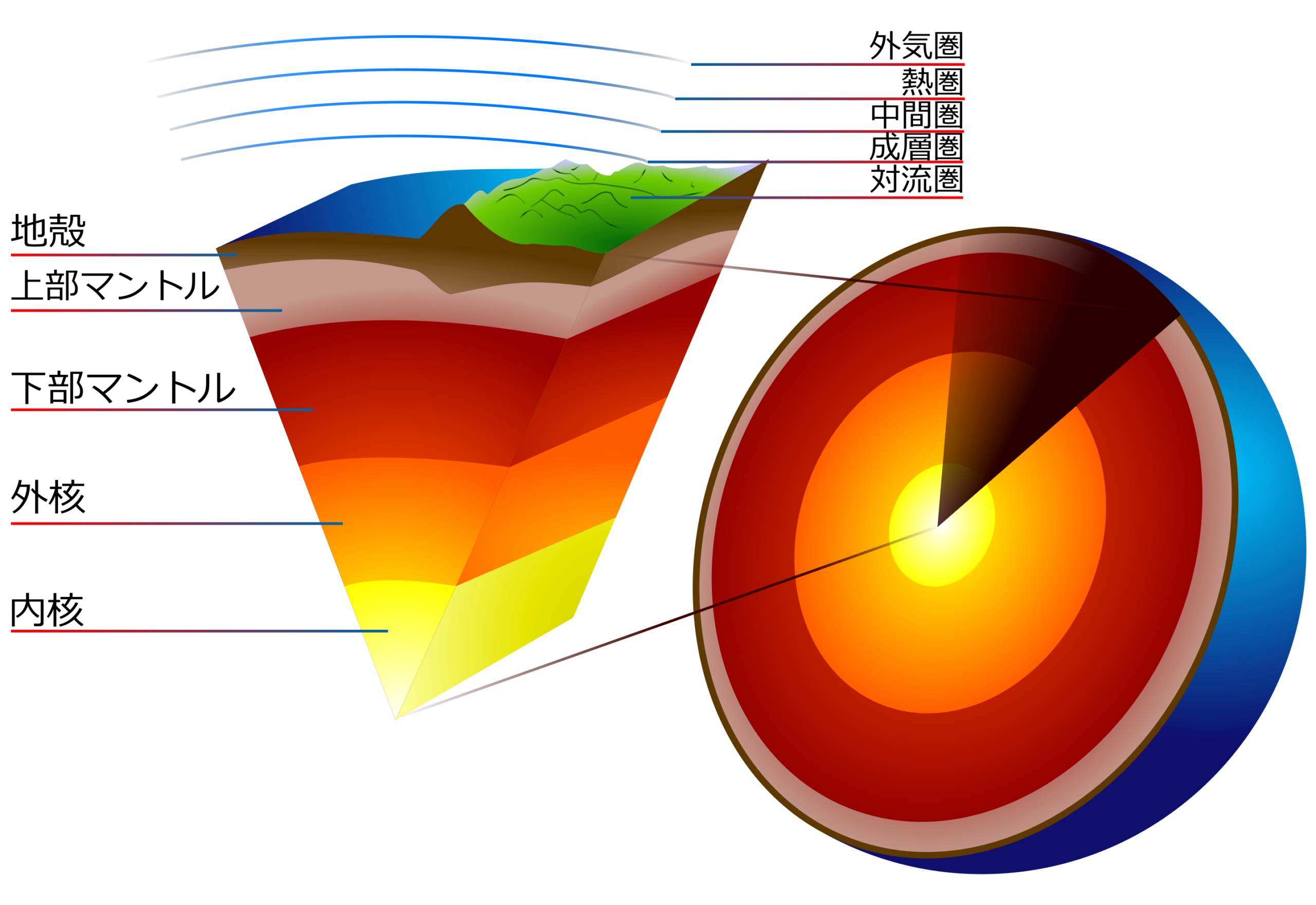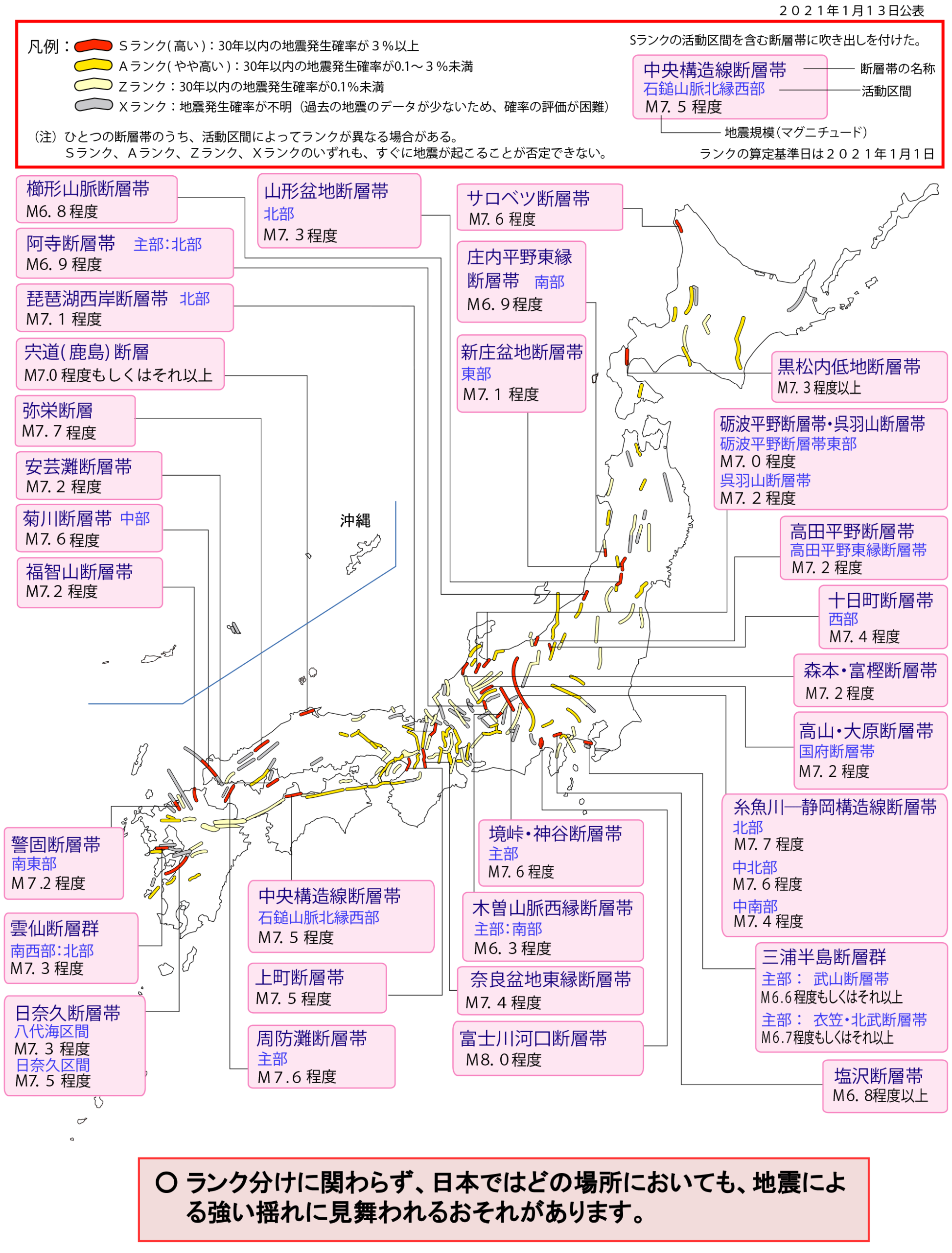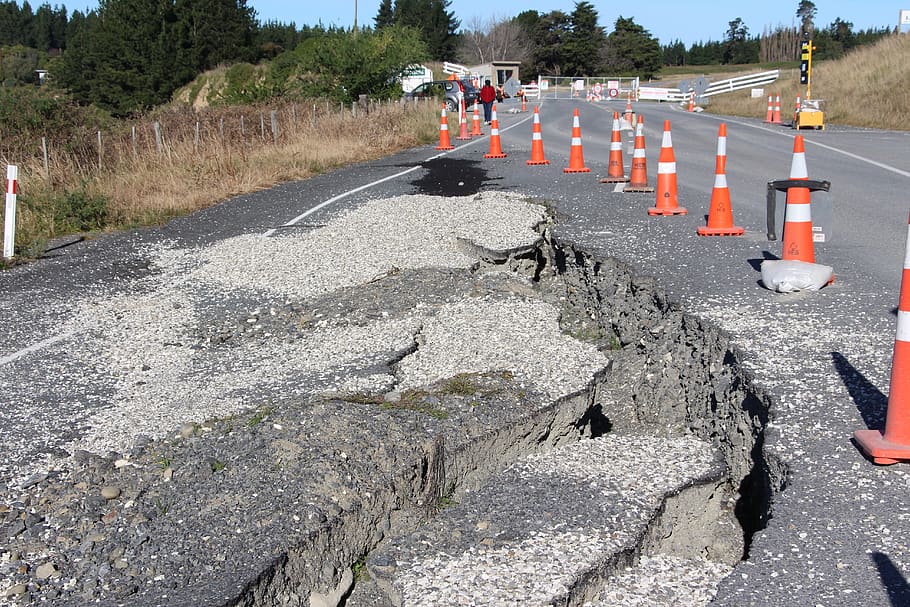キャプティブ 2022.02.15
CA34「断層型地震」に備えるキャプティブ
目次
For those who prefer to read this column in English, the Japanese text is followed by a British English translation, so please scroll down to the bottom of the Japanese text.
地球の構造は、地震波の観測、高温・高圧実験などにより、下図のような成層構造になっていると考えられている。また、「半熟卵」に例えて説明されることが多い。
地球の中心は「核」(内核・外核)、それを覆う「マントル」(上部・下部)、さらに地球の表面が「地殻」の構造である。「核」の主成分は鉄で温度は約6000℃とされ、マントルは固体の岩石であるが、上層部の一部が高温のため柔らかい「マグマ(溶岩)」となっている。その上の固い岩石部分は、「プレート」と呼ばれている。その表面を覆っている最上部が「地殻」であり、海や陸地が乗っている部分である。
現在の地球物理学では、3億年前、地球上には、「パンゲア」と呼ばれる1つの大陸しか無かったが、2億年前にそれが分裂を始めたとされている。その後、分裂によって、現在では10数枚となったプレート。その移動に応じて、上に乗った陸地も同じく移動している。このプレートが移動するという理論を「プレートテクトニクス(プレート理論)」といい、「地震発生の有力な理論的裏付け」となっている。
プレートに乗った大陸どうしが衝突することもある。インドが、豪州沖から移動してきて、ユーラシアプレートに衝突、そのエネルギーで大地に皺が誕生、それが「ヒマラヤ山脈」となった。小規模な例であるが、「伊豆半島」も衝突によって合体してできあがったものである。こう記していくと、「プレートは地球の表面を移動し続ける」と考えられるが、実はプレートにも「一生」がある。プレートの「原料」であるマグマは、長い海底火山(海嶺)から生み出され、凝固してプレートを構成する。そして、移動し、また深海の海溝深くに沈み込んでいって、消失するのである。
このプレート、日本列島に関係するものでは、ユーラシアプレート、北アメリカプレートの「大陸プレート」と、フィリピン海プレート、太平洋プレートの「海洋プレート」がある。海洋プレートは、大陸プレートよりも強固で密度が高いため、2つのプレートが衝突すると海洋プレートは大陸プレートの下に沈みこんでいく。地球を覆う、この「大規模プレート」は、14~15枚あるとされていたが、1つのプレート内で移動速度が異なる部分があることが発見され、理論に適合せず不自然となるため考え出されたのが、大規模なプレートが割れて小規模な40数枚の「小規模プレート」が存在するという考え方である。

(出典:Earth-crust-cutaway-Japanese.svg)
(Source: Earth-crust-cutaway-Japanese. svg)
1.地震の種類
地震は、その発生原因によって大きく二つに別けられる。一つが、複数のプレートの境界で発生する地震で、代表的な呼称は「海溝型地震」である。もう一つが同一プレートの内部にできた断層で発生する地震で、「断層型地震」と呼ばれるものである。また、前者は複数のプレートによって生じる地震であるので、「プレート間地震」、後者は同一プレートの内部にできた断層で発生する地震であるので、「プレート内地震」とも呼ばれるが、地震の起因を示すこともあり、一般的には「海溝型地震」、「断層型地震」と呼ばれることが多い。
東日本大震災は前者「海溝型地震」であり、陸側のプレートである「北米プレート」の下に海側のプレート「太平洋プレート」が潜り込んでいこうとして、プレートの境界にできた歪みが限界に達し北米プレートが跳ね返って発生した地震である。
関東地方は北米プレート上にあるが、フィリピン海プレートが北米プレートの下に潜り込んでいく境目に形成された相模トラフが震源となった点で、関東大震災は「海溝型地震」となる。
一方、海側のプレートが陸側のプレートに潜り込んでいくとき、陸側のプレート内部に蓄積されたていた歪みである「断層」がずれ、震源の浅い地震が発生するものが「断層型地震」である。一般的には「直下型地震」と呼ばれているものであり、懸念されている首都圏直下地震は、この「断層型地震」となる。この地震は居住地の直下で発生するため、震源が浅い場合には、局所的に激しい揺れが起こり、家屋の倒壊や火災などを引き起こし、直接的に大きな被害をもたらす。「阪神・淡路大震災」がこれにあたる。
2.断層
「地殻」の表面、地表に割れ目ができ、割れ目の両側の土地がそれぞれ違った動きをすることを「断層運動」と言うが、この動きの結果、「地層に食い違い」ができる。これが「断層」である。断層面が傾いている場合、断層ができた場所、断層面を境として両側の土地が上下方向に動いたことを「縦ずれ断層」と呼び、両側が水平方向に動いたことを「横ずれ断層」と呼ぶ。
下図「主要活断層の評価結果」(出典:政府「地震調査研究推進本部」ホームページ)に日本全国の多くの断層が記されているが、日本列島を二分して東西に別ける大地溝帯、「フォッサマグナ」(「中央地溝帯」もしくは「大地溝帯」とも呼ぶ)、この西縁が「糸静線」として有名な「糸魚川静岡構造線」、東縁が新発田小出構造線及び柏崎千葉構造線である。このフォッサマグナを境にして、中部地方から西日本にかけては「横ずれ断層」が多いと言われている。しかし、地震によって発生した「地震波」が伝わっていく地盤の構成、強弱によって、ある地点で起こす地面や地中の揺れを「地震動」と呼ぶが、この地震動が複雑な動きを見せるため、「明確に『縦ずれ断層』、『横ずれ断層』と定義できるものは希である」と言われている。
政府「地震調査研究推進本部」のホームページには、首都圏直下地震等、直下型の大地震を引き起す、主な活断層を対象にして、地震の規模、地震の発生確率などの評価結果を記した「主要活断層の評価結果」が掲載されている。
主要活断層の評価結果
Evaluation Results of Major Active Faults

出典:「主要活断層の評価結果」(地震調査研究推進本部)
Source: “Evaluation Results of Major Active Faults” (Earthquake Research Promotion Headquarters)
3,断層型地震の特徴
上図「主要活断層の評価結果」(地震調査研究推進本部)に記されている主要活断層によって引き起される「断層型地震」の規模は、マグニチュード「6.6~7.7」の範囲にあり、例外的に「富士川河口断層帯」によって起きる地震のみが「8.0」となっている。東日本大震災のマグニチュード9.0のよう、マグニチュード9台が予見されている「海溝型地震」の大きさに比べるとその大きさは、「数百分の一程度」である。
しかし、「海溝型地震」が地震発生からある程度の時間が経過してから人々が居住する地域にその地震動が押し寄せることと比べてみると、「断層型地震」は人々の居住する地域の直下にある断層が動いて発生する地震であるため、地震動は瞬時におとずれ、人々に「避難の余裕を与えない特徴」を持っている。「阪神・淡路大震災」のように、「地震の規模、大きさは海溝型地震に比べて小さいが、この特徴のために甚大な被害を与えることが多い地震」でもある。
4.断層型地震に備えるキャプティブ
これまで見てきたとおり、「断層型地震」は、規模は海溝型地震に比べて小さいが、「海溝型地震」は震源が陸地から離れた場所にあり、「地震発生から避難までにある程度の余裕がある」のに比べて、「断層型地震」は居住地の直下で発生する地震であるため「避難までにその余裕がない」。こういう点を考慮に入れ、キャプティブを設立するために購入する地震保険の設計もこの点に配慮した「保険設計にする必要」がある。
キャプティブからの再保険を引受けるロンドン・マーケットの再保険会社との交渉は、グローバル・リンクが業務提携している「マルニックス」のような保険・再保険ブローカー(保険仲立人)に依頼するが、この前提となる「元受保険の設計」に関しては、元受保険会社に「一般的な地震保険の提案と見積もりを依頼する」のではなく、その前にグローバル・リンクのようなリスクマネジメントの専門企業のサポートとアドバイスを受けながら、入念に自社のリスクマネジメントをおこない保険設計することが肝要である。
一般的にキャプティブを設立する場合、「保険代理店」を事業の柱としている企業の仲介で進めていくことが多いが、ここで注意が必要なことは、「保険代理店の事業は、『保険を売ることである』ということ」を理解しながら進めていくことである。
「リスクマネジメントの専門企業」は「保険を売ることが事業の柱ではなく、リスクマネジメント(=あるときは、保険の購入をせず、別の方法でリスク・ヘッジをすることを考案、提案)することが事業の柱である。そういうリスクマネジメントの専門企業の目で、具に事業全体のリスクを洗い出し、とりわけ「地震リスクへの対応をどうするのか」を専門家の目から評価して、「断層型地震」、その多くは「直下型地震」であるが、「断層上に事業所、工場等がある場合」には、「断層型地震」特有のリスクと被害想定を的確にリスクマネジメントした上で、地震保険の手配を進めていくことが肝要である。

今回のまとめ
企業の地震保険は、一見、引受保険会社の引受判断に委ねられていように見えるが、最終的な引受判断は引受(元受)保険会社に対して再保険補償を提供する再保険会社との協定、「再保険契約」によって決まる。日本には大きな3つのメガ損保グループが存在しているが、海外の再保険会社のサポート無しには「地震保険」を維持していくことは困難であり、各メガ損保グループでも「地震保険の補償枠」は大事に使っている。
こういう点から、元受保険会社の「再保険枠」を使うことなく、独自に海外の再保険会社と交渉して用意した地震保険の再保険を元受保険会社に提供することは、元受保険会社の引受力をサポートすることになるため、「キャプティブの設立を積極的にサポートしようとする先進的な損害保険会社」であれば彼らのサポートを容易に得ることができる。
発生したときには「甚大な損害を被る可能性のある地震リスク」であるが、また「何時起きるのか誰も予測できないリスク」でもある。このため、大地震等への対応の必要性が叫ばれているが、「何時起きるか解らない、また起きないかもしれない地震には、高い保険料は出せない」と、いまだに多くの企業で掛けられていない保険でもある。しかし、これまでのコラムで種々述べてきたように、「実際に掛かる保険コストを大きく削減することができるキャプティブは、地震保険を掛けるための有効な手段」となる。
グローバル・リンクは、巨大地震やサイバー攻撃等、企業経営に甚大な影響を与えるリスクに対するリスクマネジメント・コンサルティングを行っている。その目的は「顧客のTurning Risk to Profit® (リスクの収益化:事業上のリスクを逆に事業収益化することを目的とする企業戦略)を実現すること」であり、そのために信頼性と安定性を最重視する「ソリューション・キャプティブ®」(リスクマネジメント上の課題を解決、企業戦略に「ソリューション(解)」を与えるキャプティブ)を設立、運営管理する、リスクマネジメント分野の専門企業である。
ただ、日本では、「本来はリスクマネジメントの一分野である保険がリスクマネジメントとイコール」と考えられている点、リスクマネジメントの説明の過程で、「募集を意図せずとも保険の説明も入ってくる」点などから、損害保険代理店資格を社員全員が取得、またグローバル・リンクも保険代理店として登録して、「リスクマネジメントと保険の業際」で法的な問題を惹起させないようにしている。しかし、グローバル・リンクの主要事業は、あくまでも「リスクマネジメント」業である。
「地震リスク=地震保険を掛ける」ということではなく、その前に地震によって自社の主要な財物がどのような被害を受ける可能性を持っているのか、また「予防措置は取れないのか」等のリスクマネジメントを入念におこなうことが重要である。
そのことによって、「掛けなくてもいい部分が明確になり、補償が本当に必要な対象に対して地震保険を的確に掛けることできる」からである。そのうえで、キャプティブを設立すれば、キャプティブ設立の効用を最大化することができるのである。
執筆・翻訳者:羽谷 信一郎
English Translation
Captive (CA) 34 – Captives prepared for ” fault earthquakes”
The Earth’s structure is often compared to that of a half-boiled egg, based on observations of seismic waves and high-temperature and high-pressure experiments.
The centre of the Earth is the core (inner and outer), the mantle (upper and lower) covers it, and the surface of the Earth is the crust. The mantle is solid rock, but some of the upper layers are soft magma (lava) because of the high temperatures. The solid rock above is called the plate. The uppermost part of the plate is the crust, which is where the oceans and land are located.
According to current geophysics, 300 million years ago there was only one continent on Earth, called Pangaea, which began to break up 200 million years ago. Since then, the plate has split into a dozen or so plates. As the plates have moved, the land on top of them has moved as well. This theory of plate movement is known as plate tectonics, and is a powerful theoretical basis for the occurrence of earthquakes.
Continents on plates can also collide with each other. When India moved from off the coast of Australia and collided with the Eurasian plate, the energy created wrinkles in the earth and the Himalayas were formed. On a smaller scale, the Izu Peninsula was also formed as a result of the collision. We might think that plates continue to move across the surface of the Earth, but in fact they have a life of their own. Magma, the “raw material” for plates, is produced by long submarine volcanoes (ocean ridges) and solidifies to form plates. They then move, sink into deep ocean trenches, and disappear.
There are two types of plate: continental plates, such as the Eurasian Plate and the North American Plate, and oceanic plates, such as the Philippine Sea Plate and the Pacific Plate, which are related to the Japanese archipelago. The oceanic plates are stronger and denser than the continental plates, so when the two plates collide, the oceanic plates sink beneath the continental plates. It was thought that there were 14 or 15 of these “large plates” covering the Earth, but it was discovered that there were parts of each plate that moved at different speeds, which didn’t fit the theory and made it unnatural, so the idea that there were 40 or so smaller “small plates” that broke off the large plate was invented.
1. Types of earthquakes
Earthquakes can be divided into two main types according to their cause. The first type is an earthquake that occurs at the boundary of several plates, and is typically called a trench earthquake. The other type of earthquake occurs on faults within the same plate and is known as a fault earthquake. The former are called “interplate earthquakes” because they are caused by multiple plates, and the latter are called “intraplate earthquakes” because they are caused by faults formed inside the same plate, but they are often referred to as “trench earthquakes” and “fault earthquakes” in general, as they may indicate the origin of the earthquake.
The Great East Japan Earthquake was the first type of “trench earthquake”, which occurred when the Pacific Plate, the plate on the ocean side, tried to submerge under the North American Plate, the plate on the land side, and the North American Plate bounced back when the strain at the plate boundary reached its limit.
The Kanto region is on the North American Plate, and the Great Kanto Earthquake was caused by the Sagami Trough, which was formed at the boundary between the Philippine Sea Plate and the North American Plate, making it a trench-type earthquake.
On the other hand, when the oceanic plate submerges into the land plate, the strain accumulated inside the land plate (fault) shifts, causing a shallow earthquake with a shallow epicenter, which is a “fault-type earthquake” and is generally called a “direct-type earthquake”. These earthquakes occur directly beneath residential areas, and if the epicentre of the earthquake is shallow, the shaking will be localised and severe, causing houses to collapse and fires to break out, resulting in direct damage. The Great Hanshin-Awaji Earthquake is a case in point.
2. fault
When a crack appears in the surface of the earth’s crust, the land on both sides of the crack moves differently, which is called fault movement, and as a result there is a discrepancy in the strata. This is a ” fault “. When the fault plane is tilted, the land on both sides of the fault moves up and down with the fault plane as the boundary, which is called a “vertical displacement fault”, and the land on both sides moves horizontally, which is called a “horizontal displacement fault”.
The figure below, “Evaluation Results of Major Active Faults” (Source: Government of Japan’s Earthquake Research Promotion Headquarters website), shows many faults throughout Japan. The western edge of the Fossa Magna is the “Itoigawa-Shizuoka Tectonic Line”, also known as the “Itoshizu Line”, and the eastern edge is the Shibata-Koide Tectonic Line and the Kashiwazaki-Chiba Tectonic Line. However, the shaking of the ground and underground caused at a certain point by the composition and strength of the ground through which the seismic waves generated by an earthquake are transmitted is called “seismic motion”, and because this seismic motion shows complex movements, it is said that “there are few faults that can be clearly defined as “vertical displacement faults” and “horizontal displacement faults”.
On the website of the Headquarters for Earthquake Research Promotion of the Government of Japan, there is the “Evaluation Results of Major Active Faults” which describes the results of the evaluation of the scale of earthquakes and the probability of occurrence of earthquakes on the major active faults that cause major earthquakes such as those directly beneath the Tokyo metropolitan area.
3. Characteristics of fault-type earthquakes
The scale and magnitude of fault earthquakes caused by the major active faults shown in the above figure “Evaluation Results of Major Active Faults” (Earthquake Research Promotion Headquarters) are in the range of “6.6 to 7.7”, with the exception of the earthquake caused by the “Fujikawa Kawaguchi Fault Zone”, which has a magnitude of “8.0”. The magnitude of the earthquake is only a few hundredths of the magnitude of trench earthquakes, which are predicted to have magnitudes in the 9 range, such as the magnitude 9.0 of the Great East Japan Earthquake.
However, in comparison with the trench earthquakes, in which the tremors hit the area where people live some time after the occurrence of the earthquake, the fault earthquakes are caused by the movement of a fault directly underneath the area where people live, so the tremors hit instantly and do not give people time to evacuate. Although the scale and magnitude of earthquakes are smaller than those of trench earthquakes, they often cause enormous damage because of this characteristic.
4. Captive preparation for fault earthquakes
As we have seen, the magnitude of fault earthquakes is smaller than that of trench earthquakes, but the epicentre of trench earthquakes is located far from the land and there is a certain amount of time between the occurrence of the earthquake and the evacuation, whereas fault earthquakes occur directly beneath the residential area and there is no time to evacuate. In this respect, the design of the earthquake insurance policy purchased to establish a captive must take this into account.
In other words, when negotiating with a London market reinsurance company to underwrite the reinsurance from the captive, an insurance or reinsurance broker such as Marnix, with whom Global Link works, should not ask the primary insurer to “provide a general earthquake insurance proposal and quote”. Rather, it is essential to carefully manage your risks with the support and advice of a specialist risk management company such as Global Link.
It is common for captives to be set up through the intermediary of a company whose core business is that of an insurance agent. It is important to understand that the business of an insurance agent is to sell insurance.
A “risk management specialist” is not in the business of selling insurance, but in the business of risk management (i.e., devising and proposing alternative ways of hedging risks, sometimes without buying insurance). In the eyes of a company specialising in such risk management, the risks of the whole business are identified in detail and, in particular, the question of how to deal with earthquake risks is assessed from the point of view of an expert, and after risk management of the specific risks and measures to deal with “fault earthquakes”, most of which are “direct earthquakes”, “earthquake insurance” is arranged. insurance arrangements”.
Summary of this issue
Corporate earthquake insurance is, in one respect, left to the underwriting decision of the underwriters, but the final underwriting decision is determined by the “reinsurance contract”, an agreement with a reinsurance company that provides reinsurance coverage to the underwriter.
In Japan, there are three large non-life insurance groups, all of which are very concerned about earthquake risks and would find it difficult to maintain earthquake insurance without the support of overseas reinsurers, since there is a high level of interest in earthquake risk.
From this point of view, providing earthquake insurance reinsurance to primary insurers without using the “reinsurance quota” of the underwriters, which is prepared by negotiating with overseas reinsurance companies on their own, will support the underwriting capacity of the primary insurers, and any advanced non-life insurance company that is willing to support the establishment of captives can easily obtain their support.
An earthquake is a “potentially catastrophic risk”, but also “a risk that no one can predict when it will happen”. For this reason, the need to deal with major earthquakes has been raised, but many companies still do not take out insurance because they cannot afford the high premiums for an earthquake that may or may not happen. However, as we have discussed in previous columns, captives are an effective way to insure against earthquakes as they can significantly reduce the actual cost of insurance.
Global Link provides risk management consultancy for risks such as earthquakes and cyber-attacks that can have a significant impact on business operations. Global Link’s objective is to help clients achieve Turning Risk to Profit® (a corporate strategy that aims to turn business risks into business profits). To this end, the company is a specialist in the field of risk management, establishing, operating and managing Solution Captives® (captives that solve risk management problems and provide “solutions” to corporate strategies), with a focus on reliability and stability.
In Japan, however, there is a perception that insurance, which is essentially a part of risk management, is equal to risk management, and that the process of explaining risk management includes explaining insurance without intending to sell it. Global Link is also registered as an insurance agent to avoid any legal problems in the “risk management and insurance” business. However, Global Link’s main business is “risk management”.
It is not enough to say that “earthquake risk = earthquake insurance”, but it is important to carry out risk management to determine what damage could be caused to the company’s main assets by an earthquake, and whether preventative measures can be taken. This will help to identify the areas that do not need to be insured and to ensure that earthquake insurance is taken out for those areas that really need it. If a captive is then established, the benefits of establishing a captive can be maximised.
Author/translator: Shinichiro Hatani

